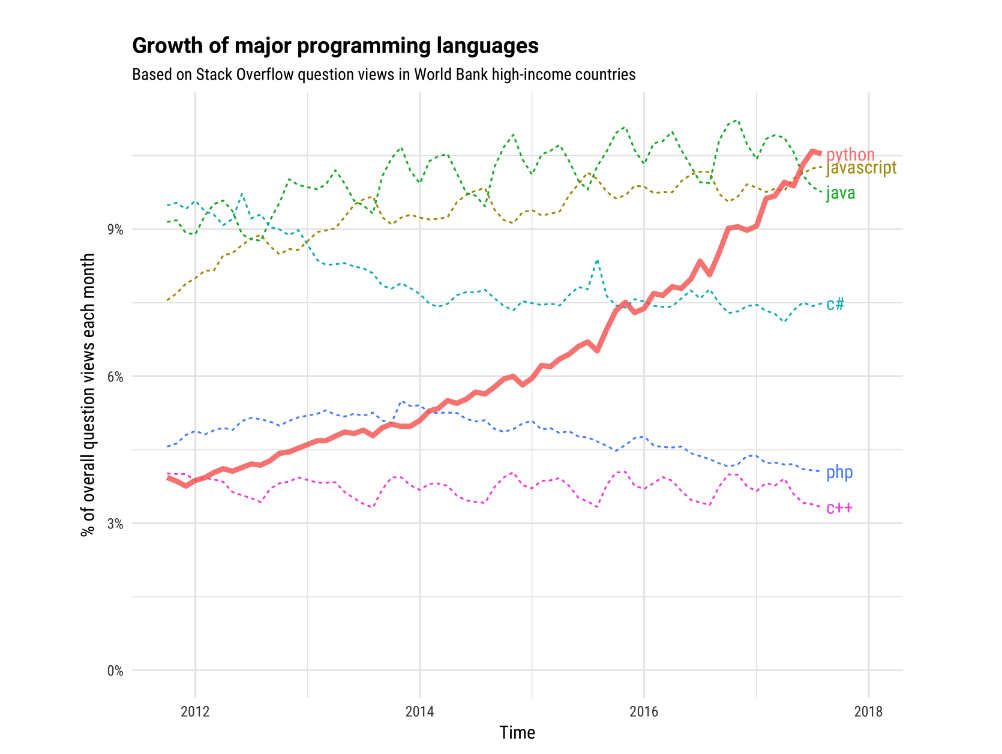So you’re thinking about learning to code in 2018. It’s proven that a career in coding is both fulfilling and in-demand. But what programming language should you learn? Quite simply: Python. Below, we explore why you should learn Python in 2018.
Python’s Recent Spike in Popularity & Growth Trends
To start off, it’s important to note Python’s recent growth in popularity. The language’s growth in interest over the last few years is hard to ignore and yet stumping data scientists. Not long ago, it was thought to already be a dead language.

According to Stack Overflow’s 2018 Developer Survey, this past year alone, Python has risen in the ranks as one of the most commonly used programming languages, surpassing C# this year, much like it had surpassed PHP last year, visible in the chart above. It’s also considered as the most wanted language for the second year in a row, meaning developers who do not yet use Python say they intend on learning it soon. It’s safe to say Python is the fastest-growing major programming language.
So what’s the main reason for this recent spike in Python interest?
Interestingly enough, there is an equal rise of interest in data science and machine learning. Python and data science go hand-in-hand. Quora supports this by advancing reasons why Python is the language of choice for data scientists. Additionally, you’ve probably heard the saying, ‘Data is the New Gold.’ And when it comes to data, Python is probably the most used programming language in Data Science.
Why is Python used so widely in data science? One important reason is that powerful statistical and numerical packages exist in Python for data analysis (such as PyBrain, NumPy and MySQL). Anyone comfortable with the Python programming language can use it as a tool to organize, process, and visualize data. Even if programmers are not in a Data Science field, Python is still useful to them because most programmers deal with data, in one way or another, in their day-to-day work.
Although plenty of other programming languages are useful in the field of data science, such as SQL and R, Python is one of the more versatile, with over 125,000 third-party Python libraries available as a resource.
Let’s get into the specifics
Python Fast Facts |
| Average Salary: $107 000 |
| Top Job Locations: New York City, Mountain View, San Francisco |
| Top Employees of Python Programmers: Intel, Amazon, Dell |
| Python was used to build: Instagram, YouTube, Spotify |
So, what’s Python all about? It’s a programming language developed in 1991 which, according to Inc., is used for:
- Web development: it’s great for back-end web development (if you’re unsure about the difference between front-end and back-end web development, read this)
- Video game development
- Desktop GUIs (Graphic User Interfaces)
- Software development/engineering
The Benefits of Python
- It’s an easy language to learn. Responses to questions about Python on Software Engineering Stack Exchange, a Q&A answer site, indicate that it’s one of the first languages newbie developers should learn, because it’s simple to read. In fact, it reads similarly to English, which means it removes a lot of syntax-learning stress from coding beginners. Python handles the complexity for you.
- It contains object-oriented (OO) concepts. Basically, in Object-Oriented Programming, objects contain data, or attributes, and interact with other objects via procedures. Other well-known OO languages include Java, C++, C#, PHP, Ruby, Perl, etc.
- Python has a large library of great tools and functionality that makes building things relatively easy. A library is a collection of resources used by software programs to develop software. This could include configuration data, help data, message templates, pre-written code, documentation, etc.
- Python is one of the top four languages for building IoT, or Internet of Things, solutions. IoT is really about connecting things – such as coffee makers, washing machines, lamps, etc. – to one another via the Internet, explains Forbes. Most things that have ‘on’ and ‘off’ switches can be part of IoT.
- Community help exists for Python. As you become a coder, you’ll realise how important the developer community is, and how the larger the community, the more likely you’ll get help when you need it. Python has the 5th largest StackOverflow community, a popular Q&A programming site.
- Python appears to be the fastest-growing language, particularly in high-income countries such as the UK, UK, Germany and Canada. In June 2017, Python was the most visited tag from high-income countries on Stack Overflow – with 27% year-on-year growth.
In closing, if you’re keen to learn coding this year, it’s a great idea to learn Python in 2018. HyperionDev offers a six month online Software Engineering Bootcamp, which includes Python as part of its back-end programming.


